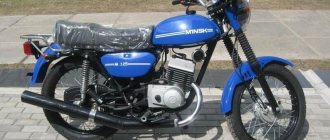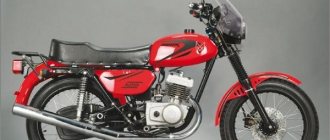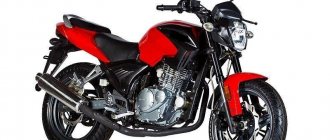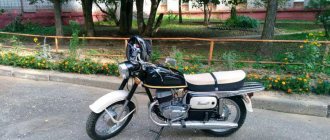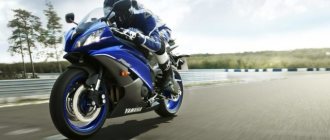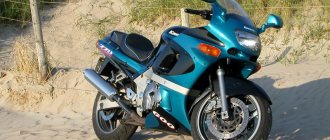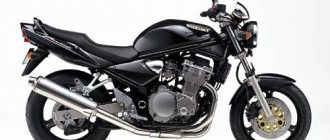Quite a few motorcycles of various brands travel along the roads of the Northern Urals. Here you can meet the brainchildren of various motor plants in Russia and the CIS. Among them are “IZhi”, “Voskhody”, “Ural”, sometimes you can find some “Dnepr” of a furry vintage. But the constant representative of the entire family of motorcycles remains “Minsk”, or, as it is called here, “Kozel”, which will be discussed below.
Meet the MMVZ 3.112.11 “Minsk” motorcycle for rural areas, manufactured in 1988, engine displacement 125 cm3, engine power 10 hp. The motorcycle received the prefix “for rural areas” for a reason - it differs from previous models in a modernized engine (more torquey at low speeds), a raised front fender, modified lighting equipment, a new raised muffler and a wide handlebar with a crossbar.
Over its 15 years, “Minsk” covered about 10 thousand kilometers of the Ural off-road, and was a regular participant in trips to nature, to the forest, to pick mushrooms and berries. And it still remains on the move, it starts up as they say “with half a kick” (unlike the owners of “Voskhods” and “Owls”), numerous falls and years of operation have not broken the fighting character of this small motorcycle.
Now a little about operation. Almost in the very first month we had to abandon the fashionable raised front wing, because in rainy weather all the road dirt settled in an even layer on the driver’s clothes and on the engine. The problem was solved by installing a wing from an M-106 motorcycle.
A little later, the switch unit located under the seat failed. The problem was solved by replacing the switch with a new one. By the way, the motorcycle is equipped with new lighting equipment, a 12-volt generator (previous Minsk models had 6-volt ones) and new, imported switches on the steering wheel, which, unlike Russian ones (IZh owners will understand), do not rattle and do their job perfectly.
A few words about the direction indicators. It is not clear why new motorcycles now come with plastic indicators? When driving in the forest, they often get caught on branches and simply break off. Fortunately, this “Minsk” still got old, aluminum turn indicators, which, surprisingly, withstood the frequent falls of the motorcycle.
After one of the stops, we found a motorcycle lying on its side. The reason is a broken center stand. At that time, it was impossible to find such a valuable part in stores, so they decided to weld a side stand from a Tulitsa scooter to the frame. Later, we finally bought a footrest and now they complement each other perfectly, that is, if desired, you can put it on the central (extremely unstable due to the narrow width) or side footrest.
After hitting an unfortunate bump on a forest road, the gear shift lever fell off. Using pliers, we switched gears and somehow made it home in 2nd gear. The shift lever was returned to its place, again with the help of welding, however, the “high society of garage minds” prophesied that such a design would not last long, but, nevertheless, everything still works with a bang.
During long-term use, the bracket holding the license plate broke due to vibration. After some work, the bracket was replaced with a homemade one, cut from a piece of sheet steel - now if the bracket breaks, it will only be with the rear wing.
The oil in the rear shock absorbers has been changed several times. Due to their old age, rubber seals leak oil and shock absorbers constantly “sweat” oil. And recently the spring in the right shock absorber gave up its life for a long time - frequent overloads did their job and it broke.
I would like to note that despite all the road troubles, they tried to more or less take care of the motorcycle. The motorcycle went through a break-in, after which they didn’t even remove the rev limiter in the carburetor, but only sawed it halfway. The oil in the gearbox was changed annually; we still fill it with gasoline mixed with oil in a ratio of 20:1 (for ten liters of gasoline, half a liter of oil). Over the entire period of operation, the tires were completely changed; numerous paint chips on the Minsk required painting over.
With such little and often untimely maintenance, “Kozlik” can still achieve the stated rated speed of 85 km/h (according to the speedometer) on the highway; it starts, as I already said, with “half a turn” and, especially, never will not let you down on a broken forest road.
Concluding my story, I would like to thank the team of the Minsk Motorcycle Plant for such an excellent motorcycle. If even in the Northern Urals you can find motorcycles from this plant that are 20 or even 30 years old, then, you must agree, this speaks of the reliability of the equipment of this brand.
Andrey KRUPIN
Motorcycle MMVZ-3.11215 “Pioneer”
The basic version of MMVZ-3.112.12 entered production in 1991. The MMVZ-3.112.14 “Pioneer” modification is distinguished by a semi-fairing with a rectangular headlight, and the MMVZ-3.112.15 “Pioneer” version also received a telescopic front fork with aluminum sliding pipes. The same khaki-colored car is intended for border guards.
The MMVZ-3.11215 “Pioneer” motorcycle is a further modernization of the base model MMVZ-3.11212 and has all the advantages of a simple and reliable road motorcycle. At the same time, a number of innovations have been applied to its design, which significantly improve its technical, operational and other consumer properties. Among the technical innovations, this is, first of all, a new front fork with aluminum sliding pipes and an increased diameter of the supporting pipes, which made it possible to increase the rigidity of the front fork, the stability of the motorcycle on the road and the smoothness of the ride. The design of the motorcycle has been significantly improved.
A new shaped headlight, headlight fairing, and direction indicator lights were installed. A decorative overlay with the inscription “Minsk” and side reflectors is installed on the lower bridge of the front fork. The new plastic front fender of the original shape harmonizes well with the headlight fairing and gives the motorcycle a modern appearance. The design of the motorcycle includes a new set of sticky applications.
Technical characteristics of Minsk Pioneer:
Maximum engine power - 7.36 kW (10.0 hp)
- Length, height, width, mm - 2100x1300x800
- Base, mm - 1230
- Dry weight, kg - 115
- Engine displacement, cm3 - 125
- Piston diameter, mm - 52
- Piston stroke, mm - 58
- Cooling system - air
- Tact - 2
- Number of gearbox gears - 4
- Ignition type - electronic
- Main gear - chain
- Front fork - telescopic
- Front tire - 3.00-18″ or 3.00/80-18″
- Rear tire – 3.00-18″ or 3.00/80-18″
- Maximum speed, km/h - 85
- Fuel consumption, l/100 km — 3.5
- Tank capacity, l - 11
- Fuel - gasoline with an octane rating of at least 80 mixed with oil
Motorcycles produced by the Minsk plant are familiar to motorcyclists. In 1968, serial production of the Minsk M-105 motorcycle began, which in its technical parameters significantly exceeds previous models.
The release of a new car always causes great interest among owners of old models. What parts of the new design will fit with the old ones and from the old ones to the new one, what alterations will be required to give a new heart to a “weakened” veteran - these are the main questions that concern them. Readers are interested, of course, in why the power increased with the same “cubes”. The purpose of the published article is to answer these questions.
First of all, what is the Minsk M-105 motorcycle? Briefly - M-104 with a completely new power unit (engine with gearbox) and a closed reverse gear. But there are other differences: when you press the brake pedal, the brake light comes on: the new B-300 ignition coil together with the G-411 generator provides a more powerful spark on the spark plug, etc.
Let's talk a little more about the engine. Its working volume, like that of the M-104, is 123 cm3, the compression ratio is 8 ± 0.2. Engine power increased from 5.5 liters. With. at 5000-5200 rpm. up to 7 l. With. at 5200-5500 rpm. This was achieved by careful selection of the size, shape and location of the windows and cylinder channels, as well as the use of a K36M carburetor with a diffuser with a diameter of 22 mm.
The new engine adapts better to different road conditions thanks to a four-speed gearbox instead of the M-104's three-speed gearbox.
Fig 1. Engine M-105 (cross section) : 1 - cylinder head; 2 - cylinder; 3 - piston; 4 — piston pin; 5 — piston pin retaining ring; 6 — connecting rod; 7 — oil seal; 8 — bearing; 9 — retaining ring; 10 — spacer sleeve; 11 — left half of the crankcase; 12 — motor transmission chain; 13 - key; 14 — washer; 15 - nut; 16 — driving gear; 17 — oil dipstick; 18 — gear shift pedal; 19 — clutch; 20 — ratchet gear of the trigger mechanism; 21 - bearing; 22 — left crankcase cover; 23 — thrust washer: 24 — sealing ring; 25 — trigger shaft; 26 — kick starter lever; 27 - screw; 28 — sector spring; 29 — centering pin; 30 — fork axis; 31 — shift fork for 1st and 3rd gears; 32 — gear shift disc; 33 — pedal return spring; 34 — adjusting screw; 35 - lock nut; 36 — right crankcase cover; 37 — fork for shifting II and IV gears; 38 — gearbox cover; 39 — right cover plug; 40 — drive gear of the main gear; 41 — clutch adjusting screw; 42 — spacer sleeve; 43 — oil seal; 44 — secondary shaft bearing; 45 — gasket of the oil seal housing; 46 — hole for lubrication of the right crankshaft bearing; 47 - generator; 48 — crankshaft outer oil seal; 49 — crankshaft gasket; 50 - right half of the crankcase; 51 — spark plug; 52 - decompressor.
An idea of the engine structure is given in Fig. 1. Increasing power required strengthening the main loaded parts so that the durability of the engine was not reduced. To facilitate thermal conditions, cylinder 2 is made of aluminum alloy with a cast iron sleeve. The liner is inserted during the casting of the cylinder and has ribs at the top that provide a more reliable connection between the surfaces of cast iron and aluminum alloy. Therefore, the sleeve cannot be pressed out for replacement. The crankshaft has undergone a radical modification. The connecting rod 6 is reinforced, and the bearing of its lower head has 24 4x6 rollers. installed in the launa separator. The separator eliminates mutual friction of the rollers at high speed, and consequently, overheating of the unit. Thanks to this, it lasts longer. Trunnions are pressed into the solid-turned (without plugs) cheeks of the crankshaft, which rest on three bearings 8 (No. 303). To increase durability, the bearings are lubricated with oil from the gearbox housing. Rubber seals 7 measuring 47x20x10 are installed between the crank chamber and the bearings. Lubricant is supplied to the right bearing and removed from it through two channels 46 in the right half of the crankcase. This design is used on domestic engines for the first time.
The motor transmission and clutch have been strengthened. The number of drive discs with cork inserts has been increased to four. The newly designed gearbox has significantly stronger gears with reinforced cams. So that the gearbox can be repaired without complete disassembly (and without removing the engine from the car), a special cover 38 is made. We will tell you more about the gearbox in another article.
The rear (main) transmission is carried out by a single-row roller chain PR-12, 2-1800-2 (like Voskhod, Tula, Java and Pannonia). It is covered with a rubber-metal casing.
Thus, the wishes of consumers to have a more powerful motorcycle with a four-speed gearbox and a closed final drive are taken into account.
Now about interchangeability. Let's focus on the main, most important engine parts regarding operation and repair. For old and new models the following are interchangeable: piston 3, piston rings, pin 4, retaining rings 5 and connecting rod upper head bushing; outer oil seal 48 of the crankshaft and oil seal 43 of the secondary shaft of the box (the oil seals themselves, and not the housings into which they are pressed): clutch discs (support, drive, driven): kick-starter and gear shift pedals. Crankshaft oil seal 7 (47x20x10) will come from Voskhod. From Voskhod, you can use drive disks (six pieces), respectively increasing the number of driven ones by two: kick-starter and gear shift pedals (the latter with adjustment).
When designing the new engine, the designers provided the ability to install it on the frames of older models with minimal modifications. Here's what they are and how they're done.
Rice. 2. Adjusting the rear engine mount
First of all, you need to adjust the rear engine mounting brackets along the contour of the crankcase (Fig. 2). Then drill the holes in the brackets to a diameter of 8.5 mm. since the engine is mounted with 8X1 bolts 45 mm long. Having installed the engine on the frame, we adjust the exhaust pipe flange so that it fits tightly to the cylinder pipe. But it’s better to install a pipe from M-105. It is imperative to purchase or make an exhaust pipe nut with an M42 X 2 thread (instead of M42 x 1.5 for older models). It is also recommended to install a muffler for the M-105. It is necessary to bend the brake pedal so that it does not touch the crankcase cover, and in addition, cut off or chop down the air filter bracket on the frame and trim the front part of the right facing of the motorcycle along the contour of the crankcase.
The spacer will have to be shortened and the sprocket or chain will have to be replaced. The fact is that for engines of older models, distance “a” (see Fig. 1) is 58 mm. and for the M-105 it is 61 mm (this is done to ensure clearance between the rubber covers of the chain and the wheel). If you decide to use a wide final drive chain (from M-105, Voskhod and other models) with an old wheel, then you should shorten the spacer sleeve 42 by 3 mm. If you use a chain from older models (narrow). then you need to shorten the bushing by 2 mm and put a narrow sprocket on the secondary shaft. For any other options, take into account the difference in chain width, teeth and distance “a”. Be sure to place the correct number of washers under the sprocket nut to securely clamp the sprocket.
Now all that remains is to adjust the length of the clutch cables and... gas, connect the wires to the generator, check the oil level in the box, pour it into the air filter - and you can go on your first trip. At the same time, do not forget about the rules for breaking in a new engine.
If you want to install a brake light on your motorcycle, you will need to purchase any type of brake light switch and a dual-bulb tail light. Having secured the switch with clamps on the frame or on a specially welded bracket, connect it with a spring to the brake pedal. Then connect the corresponding terminal (bottom) of the generator with a wire to one of the switch terminals. Connect the second terminal of the switch to the terminal of the brake light lamp (6 V. 15 spark plugs). Start the engine and... While pressing the brake pedal, check the operation of the switch. The lamp should light up. when the brake pedal moves 10-15 mm (that is, before the brakes begin to apply).
Many motorcyclists want to keep the old model engine and install only the cylinder from the M-105. Here's what you need to do for this.
Using the cylinder gasket as a template, adjust the contours of the purge ports on the cylinder and crankcase if possible. You will need a set of scrapers and files. This is not necessary, but it is advisable.
After securing the cylinder to the engine, fit the exhaust pipe flange to the cylinder connection. The pipe is attached to the pipe using a nut with an M42 x 2 thread.
Rice. 3. Adapter for carburetor K-55
Install the carburetor pipe (from M-105) with two cardboard gaskets and the K-36M carburetor onto the cylinder. For it, make a new air filter pipe from tin, adjusting the dimensions to the location. If you don’t have a K-36M carburetor, you can use an old K-55 carburetor and an old filter by first making an adapter (Fig. 3) and cutting off the filter pipe by 10 mm.
The desire of owners of older models of our motorcycles to close the final drive chain is understandable. It is not hard. You only need to install protective covers if you use a new wheel with a brake disc together with the M-105 engine. Without replacing these components, large and complex plumbing and tinsmithing work will be required.
Now some tips on the operation and repair of the engine and some components of the M-105.
Do not allow high crankshaft speeds at idle. Sooner or later, this inevitably leads to destruction of the connecting rod lower head bearing. To check that the ignition or carburetor is adjusted correctly. It is better to drive a short section of the road at maximum speed (the engine will be loaded).
Shift into gears smoothly, not jerkily. In the M-105 gearbox, the gears have three cams, rather than five, as in older models. This was done in order to strengthen the cams, but this increased the time required for their engagement.
Keep the oil in the gearbox clean. Don't forget that it also serves to lubricate the crankshaft main bearings. Periodically flush the gearbox crankcase with liquid oil (spindle oil, transformer oil), but not kerosene or diesel fuel. Pour 0.4 liters of oil into the crankcase and let the engine run in all gears, driving 2-3 kilometers. Then lay the motorcycle horizontally on its left side so that the oil can come out of the pocket on the right side of the crankcase, and hold it there for half a minute. Then drain the oil into a clean container. When the oil stops flowing, place the motorcycle on its left side again and... After holding it for 10-15 seconds, drain off the remaining oil. Carefully inspect the flushing oil. It may contain foreign inclusions that indicate a breakdown or malfunction. Let the oil settle and... filtering it. can be reused. Pour 0.5 liters of AK-10 oil into the gearbox housing.
Sometimes the M-105 engine develops quite significant axial play of the crankshaft. It is not difficult to eliminate it: you need to place adjusting washers with an outer diameter of 46 mm and an inner diameter of 30 mm under the housing of the right shaft seal so that they lie flush with the surface of the crankcase boss. The washers can be made from thin sheet metal.
Rice. 4. Lock plate
If you find that the bolts securing the rear wheel sprocket are loosening, cut two locking plates from a strip of steel 0.5-0.8 mm thick (Fig. 4) and install them under the bolts. After tightening them, bend the ends of the plates at the edges of the bolt heads.
The ignition coil has a B-300. installed on the M-105, and on other motorcycles. Quite often the wires soldered to the terminals break. Therefore, if after checking other components you are unable to get a spark on the spark plug, remove the cover on the ignition coil and check the reliability of soldering and the integrity of the wires. In case of a break, solder the leads using a flexible stranded wire.
If your motorcycle's license plate light and speedometer light bulbs frequently burn out, the light switch may be to blame. The reason is that when switching from high beam to low beam (or vice versa), it turns on these lamps before the headlight bulb filament, and then a higher voltage current flows to them. Once you understand the switch, you can troubleshoot the problem. Most often it lies in this. that the shunt plate located on top has poor contact with the terminals. The cause may be a bent plate or dirty contacts. For prevention, it is recommended to periodically clean the switch.
With proper operation, the M-105 engine will serve reliably and for a long time.
G. PILYUKEVICH, engineer
Minsk
1969N08P1415
Motorcycle MMVZ-3.11214 “Sputnik”
The MMVZ-3.11214 “Sputnik” motorcycle is a modernization of the base model MMVZ-3.11212 and has all the advantages of a simple and reliable road motorcycle. At the same time, it differs from the base model in that, in order to improve the appearance of the motorcycle and ease of use, it is equipped with a new rectangular headlight with a halogen lamp, a headlight fairing, and a set of new direction indicator lights.
Technical characteristics of Minsk Sputnik:
Engine - 2-stroke, air-cooled Engine displacement - 123.5 cm3. Maximum engine power - 7.36 kW (10.0 hp) Number of gears - 4 Ignition type - electronic Maximum speed - 85 km/h Fuel - A-76; Fuel consumption - 3.5 l/100 km; Tank capacity - 11 l Length - 2100mm; Height - 1200mm; Width - 790mm Saddle height - 780mm, Base - 1230mm Dry weight - 115 kg
